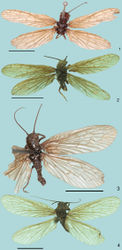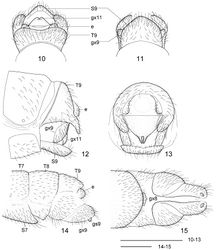Leptosialis africana
| Notice: | This page is derived from the original publication listed below, whose author(s) should always be credited. Further contributors may edit and improve the content of this page and, consequently, need to be credited as well (see page history). Any assessment of factual correctness requires a careful review of the original article as well as of subsequent contributions.
If you are uncertain whether your planned contribution is correct or not, we suggest that you use the associated discussion page instead of editing the page directly. This page should be cited as follows (rationale):
Citation formats to copy and paste
BibTeX: @article{Price2012ZooKeys201, RIS/ Endnote: TY - JOUR Wikipedia/ Citizendium: <ref name="Price2012ZooKeys201">{{Citation See also the citation download page at the journal. |
Ordo: Megaloptera
Familia: Sialidae
Genus: Leptosialis
Name
Leptosialis africana Esben-Petersen – Wikispecies link – Pensoft Profile
- Leptosialis africana Esben-Petersen, 1920: 502. Type locality: South Africa (Great Winterhoek Mountains).
Type material
Holotype, male [see remarks below] (pinned; Fig. 1), South Africa: Western Cape: “G[rea]t. Winterhoek Mts., Tulbagh [33°8'S, 19°10'E], XI.1916, K.H. Barnard / SAM-MEG-A000041 / Holotype” (SAMC).
Other material
1 male (pinned, Fig. 2), South Africa: Western Cape: “G[rea]t. Winterhoek Mts., Tulbagh, [33°8'S, 19°10'E], XI.1932, K.H. Barnard / SAM-MEG-A000042” (SAMC); 1 female (pinned), South Africa: Western Cape: “Hottentots Holland Mts., Steenbras [34°6'S, 18°58'E], XI.1932, K.H. Barnard, SAM-MEG-A000043” (SAMC); 1 male (pinned), South Africa: Western Cape: “Caledon Distr., R. Zonder End, Oudebosch [34°9'S, 19°54'E], XII.1919, K.H. Barnard / 1930-131” (NHM); 2 larvae (in alcohol), South Africa: Western Cape: “Bettys Bay, Small Vlei [34°21'S, 18°56'E], 18.I.1957, [A.D. Harrison and J.D. Agnew] / FRW 128C” (AMGS).
Diagnosis
The adults of Leptosialis africana may be easily distinguished from adults of Leptosialis necopinata sp. n. by the shape and venation of the forewing, where the wings of Leptosialis africana are narrowly rounded compared to being broadly rounded to truncated in Leptosialis necopinata sp. n. In addition, the wings of Leptosialis africana show MA and both branches of MP all simple,while Leptosialis necopinata sp. n. has MA and one or both branches of MP all bearing additional forks. The larvae of Leptosialis africana may be distinguished by the reddish brown head and thorax dorsally with distinct yellowish marks that are lacking in Leptosialis necopinata sp. n.
Description
Adult male (Fig. 2).
Forewing length 8.1 mm, hindwing length 7.0 mm (n = 1). Head (Fig. 5): pale to dark brown, frons and clypeus black; vertex with a pair of raised black vittae medially and several small, raised, black protrusions laterally. Compound eyes blackish brown, strongly produced. Antennae dark brown, pilose, approximately half the length of the forewing. Mouthparts yellowish brown, diminutive. Thorax (Fig. 5): entirely blackish brown. Legs yellow, bearing dense yellowish setae; coxae blackish brown; femora pale brown; 1st-3rd tarsomeres distally pale brown; 4th and 5th tarsomeres brown; tarsal claws reddish brown. Wings narrowly rounded, brown, slightly darker proximally; veins brown. Forewing nearly 4.0 times as long as wide; five to eight distinct costal crossveins proximally; sc-r absent; Rs distally branched, MA unbranched, MP distally branched, and CuA bifurcated; three or four crossveins between R and Rs. Hindwing slightly broader than forewing, about 3.5 times as long as wide; two or three distinct costal crossveins proximally; venation similar to forewing, with three crossveins between R and Rs. Abdomen: blackish brown. Terminalia (Figs 10–13) with 9th tergum transversely arched, with a pair of digitiform processes posterolaterally that curve slightly ventromedially; anterior and posterior margins slightly concave arcuately in dorsal view; 9th sternum slightly longer than 9th tergum; posterior margin moderately produced; 9th gonocoxite in lateral view nearly elliptical; ectoproct paired, small, roundly inflated ventrad; 11th gonocoxite broadly triangular dorsoventrally, dorsal margin slightly sinuous in dorsal view, with a pair of short and acutely hook-like processes ventrally in caudal view.
Adult female (Figs 1, 6).
Forewing length 11.1 mm, hindwing length 10.2 mm (n = 2). Larger than male, but similar in colouration and venation. Terminalia (Figs 14-15) with 7th sternum broad, posterior margin distinctly produced; 8th gonocoxite rather small, subtriangular; 9th gonocoxite broad; apex with small, stout gonostylus, ectoproct feebly sclerotized, small, suboval.
Larva (Fig. 22).
Head reddish brown; thorax reddish brown, distinctly marked with complicate patterns of yellowish marks; legs pale yellow, bearing dense setae, tarsal claws reddish brown. Abdomen blackish brown dorsally with pale yellow lateral abdominal gills.
Distribution
South Africa: Western Cape (Fig. 24).
Remarks
The type specimen was noted by Esben-Petersen in his description as male, but its abdomen and genitalia are now lost. This species of alderfly shows sexual dimorphism, with females being larger than males. Although it lacks an abdomen, the holotype is probably a female, based on comparison with confirmed male and female specimens, and contrary to the original description.
Taxon Treatment
- Price, B; Liu, X; Moor, F; Villet, M; 2012: A review of the alderfly genus Leptosialis Esben-Petersen (Megaloptera, Sialidae) with description of a new species from South Africa ZooKeys, 201: 27-40. doi
Images
|



